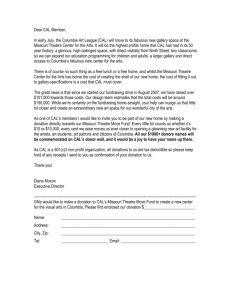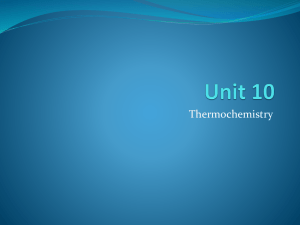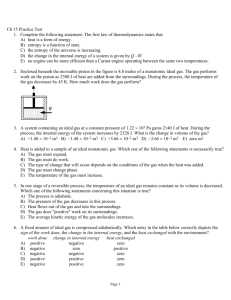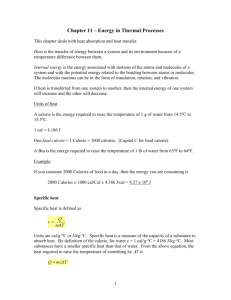Thermal Physics Test
advertisement
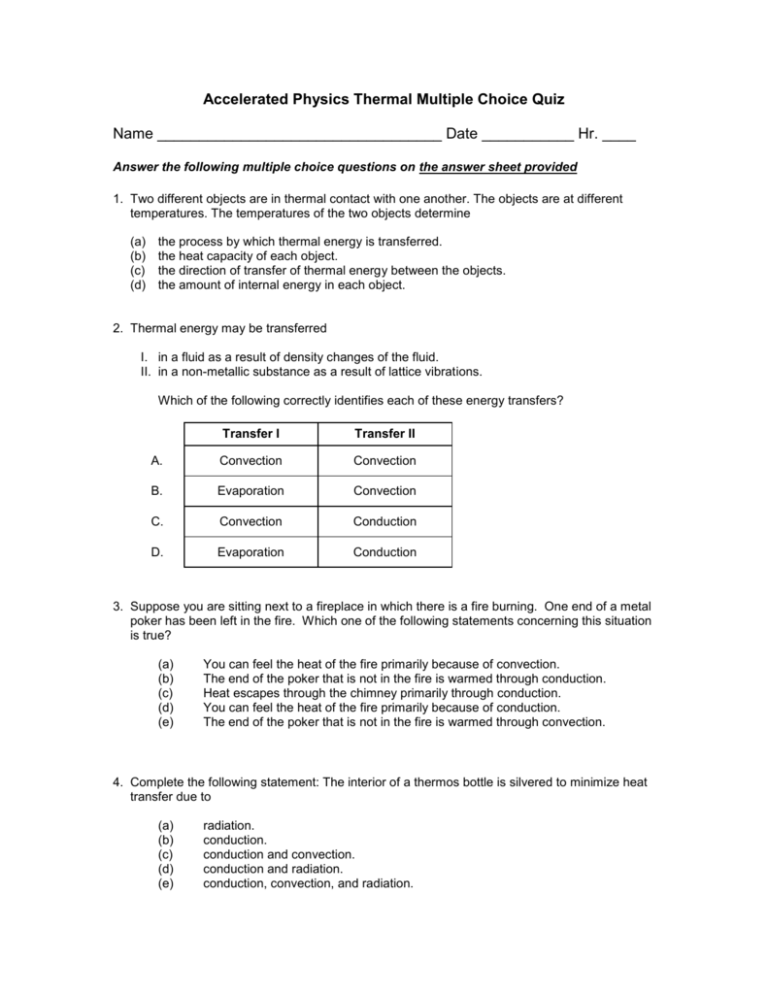
Accelerated Physics Thermal Multiple Choice Quiz Name __________________________________ Date ___________ Hr. ____ Answer the following multiple choice questions on the answer sheet provided 1. Two different objects are in thermal contact with one another. The objects are at different temperatures. The temperatures of the two objects determine (a) (b) (c) (d) the process by which thermal energy is transferred. the heat capacity of each object. the direction of transfer of thermal energy between the objects. the amount of internal energy in each object. 2. Thermal energy may be transferred I. in a fluid as a result of density changes of the fluid. II. in a non-metallic substance as a result of lattice vibrations. Which of the following correctly identifies each of these energy transfers? Transfer I Transfer II A. Convection Convection B. Evaporation Convection C. Convection Conduction D. Evaporation Conduction 3. Suppose you are sitting next to a fireplace in which there is a fire burning. One end of a metal poker has been left in the fire. Which one of the following statements concerning this situation is true? (a) (b) (c) (d) (e) You can feel the heat of the fire primarily because of convection. The end of the poker that is not in the fire is warmed through conduction. Heat escapes through the chimney primarily through conduction. You can feel the heat of the fire primarily because of conduction. The end of the poker that is not in the fire is warmed through convection. 4. Complete the following statement: The interior of a thermos bottle is silvered to minimize heat transfer due to (a) (b) (c) (d) (e) radiation. conduction. conduction and convection. conduction and radiation. conduction, convection, and radiation. 5. The diagram below shows a room in a house fitted with an electric heater used to heat the room. electric heater By which processes is the room heated when the heater is in operation? (a) (b) (c) (d) Convection only Radiation only Radiation and convection Radiation and conduction 6. The sun continuously radiates energy into space, some of which is intercepted by the earth. The average temperature of the surface of the earth remains about 300 K. Why doesn’t the earth’s temperature rise as it intercepts the sun’s energy? (a) The earth reflects the sun’s light. (b) The earth radiates an amount of energy into space equal to the amount it receives. (c) The energy only raises the temperature of the upper atmosphere and never reaches the surface. (d) The thermal conductivity of the earth is low. (e) The heat is carried away from the earth by convection currents. 7. The kelvin temperature of an object is a measure of (a) (b) (c) (d) the total energy of the molecules of the object. the total kinetic energy of the molecules of the object. the maximum energy of the molecules of the object. the average kinetic energy of the molecules of the object. 8. The digital sign outside a local bank reports that the temperature is 44 °C. What is the temperature in degrees Fahrenheit? (a) 56 °F (b) 79 °F (c) 99 °F (d) 111 °F (e) 120 °F 9. The specific heat capacity of iron is approximately half that of aluminum. Two balls of equal mass, one made of iron and the other of aluminum, both at 80 °C, are dropped into a thermally insulated jar that contains an equal mass of water at 20 °C. Thermal equilibrium is eventually reached. Which one of the following statements concerning the final temperatures is true? (a) (b) (c) (d) Both balls will reach the same final temperature. The iron ball will reach a higher final temperature than the aluminum ball. The aluminum ball will reach a higher final temperature than the iron ball. The difference in the final temperatures of the balls depends on the initial mass of the water. (e) The difference in the final temperatures of the balls depends on the initial temperature of the water. 10. Two cubes, one silver and one iron, have the same mass and temperature. A quantity Q of heat is removed from each cube. Which one of the following properties causes the final temperatures of the cubes to be different? (a) (b) density latent heat of vaporization (c) specific heat capacity (d) coefficient of volume expansion (e) volume 11. A soft drink manufacturer claims that a new diet drink is “low Joule.” The label indicates the available energy is 6300 J. What is the equivalent of this energy in Calories? (1 Calorie = 1000 cal) (a) (b) 0.015 Cal 0.48 Cal (c) (d) 1.0 Cal 1.5 Cal (e) 4.8 Cal 12. A 2.00-kg metal object requires 5.02 x 103 J of heat to raise its temperature from 20.0 °C to 40.0 °C. What is the specific heat capacity of the metal? (a) (b) 63.0 J/(kg ∙ C°) 126 J/(kg ∙ C°) (c) (d) 251 J/(kg ∙ C°) 502 J/(kg ∙ C°) (e) 1.00 x 103 J/(kg ∙ C°) 13. Two spheres, labeled A and B, have identical masses, but are made of different substances. The specific heat capacity of sphere A is 440 J/(kg ∙ C°) and that of sphere B is 160 J/(kg ∙ C°). The spheres are initially at 21 °C; and the same quantity of heat is added to each sphere. If the final temperature of sphere A is 72 °C, what is the final temperature of sphere B? (a) (b) 160 °C 140 °C (c) (d) 111 °C 51 °C (e) 39 °C 14. Some liquid is contained in a shallow dish that is open to the atmosphere. The rate of evaporation of the liquid does not depend on (a) (b) (c) (d) the temperature of the liquid. the temperature of the atmosphere. the depth of the liquid. the pressure of the atmosphere. 15. A liquid is evaporating, causing the liquid to cool. The temperature of the liquid decreases because (a) (b) (c) (d) the number of liquid molecules is decreasing. the mean kinetic energy of the liquid molecules is decreasing. the pressure above the liquid surface is increasing. the rate of evaporation is increasing. 16. Complete the following statement: When a substance undergoes fusion it (a) (b) freezes. sublimes. (c) condenses. (d) vaporizes. (e) evaporates. 17. A 1.0-g sample of steam at 100 °C loses 560 calories of heat. What is the resulting temperature of the sample? (a) 20 °C (b) 80 °C (c) 88 °C (d) 96 °C (e) 99 °C Questions 18 through 22 pertain to the situation described below: Heat is added to a 1.0-kg solid sample of a material at –200 °C. The graph shows the temperature of the material as a function of the heat added. 18. Which one of the following statements concerning this substance is true? (a) It boils at 300 °C. (d) It can coexist as a solid and a liquid at –50 °C. (b) It melts at –200 °C. (e) It can exist as a solid, liquid, and gas at 150 °C. (c) It is a liquid at 200 °C. 19. 20. What is the latent heat of fusion of this material? (a) 50 cal/g (c) 150 cal/g (b) 100 cal/g (d) 300 cal/g (e) 450 cal/g What is the latent heat of vaporization of this material? (a) 50 cal/g (c) 150 cal/g (e) (b) 100 cal/g (d) 300 cal/g 450 cal/g 21. What is the specific heat capacity of this substance in its solid state? (a) 0.33 cal/(g ∙ C°) (c) 1.00 cal/(g ∙ C°) (e) 3.00 cal/(g ∙ C°) (b) 0.75 cal/(g ∙ C°) (d) 1.33 cal/(g ∙ C°) 22. What is the specific heat capacity of this substance in its liquid state? (a) 0.33 cal/(g ∙ C°) (c) 1.00 cal/(g ∙ C°) (e) 3.00 cal/(g ∙ C°) (b) 0.75 cal/(g ∙ C°) (d) 1.33 cal/(g ∙ C°) 23. Heat is added to a substance, but its temperature does not rise. Which one of the following statements provides the best explanation for this observation? (a) (b) (c) (d) (e) The substance must be a gas. The substance must be a non-perfect solid. The substance undergoes a change of phase. The substance has unusual thermal properties. The substance must be cooler than its environment. 24. Which would cause a more serious burn: 30 g of steam or 30 g of liquid water, both at 100 °C; and why is this so? (a) (b) (c) (d) (e) Water, because it is denser than steam. Steam, because of its specific heat capacity. Steam, because of its latent heat of vaporization. Water, because its specific heat is greater than that of steam. Either one would cause a burn of the same severity since they are both at the same temperature. 25. Which one of the following statements concerning the mole is false? (a) (b) (c) (d) (e) The mole is related to Avogadro's number. The mole is defined in terms of the carbon-12 isotope. The mole is the SI base unit for expressing the “amount” of a substance. One mole of a substance has the same mass as one mole of any other substance. One mole of a substance contains the same number of particles as one mole of any other substance. 26. A container holds 20 g of neon (mass number 20) and also 8 g of helium (mass number 4). number of atoms of neon number of atoms of helium What is the ratio ? (a) (b) (c) (d) 0.4 0.5 2.0 2.5 27. Which one of the following statements best explains why gases are not commercially sold by volume? (a) (b) (c) (d) (e) Gas volume is negligible. Gas volume is difficult to measure. Gas volume depends on the type of gas. Gases have comparatively low densities. Gas volume depends on temperature and pressure. 28. When a gas in a cylinder is compressed at constant temperature by a piston, the pressure of the gas increases. Consider the following three statements. I. II. III. The rate at which the molecules collide with the piston increases. The average speed of the molecules increases. The molecules collide with each other more often. Which statement(s) correctly explain the increase in pressure? (a) (b) (c) (d) I only II only I and II only I and III only 29. A fixed mass of an ideal gas is heated at constant volume. Which one of the following graphs best shows the variation with Celsius temperature t with pressure p of the gas? A. B. p 0 p 0 0 t /°C C. 0 t /°C 0 t /°C D. p 0 p 0 t /°C 0 30. An ideal gas is confined within a closed cylinder at atmospheric pressure (1.013 105 Pa) by a piston. The piston moves until the volume of the gas is reduced to one-ninth of the initial volume. What is the final pressure of the gas when its temperature returns to its initial value? 9.117 105 Pa 6.447 105 Pa (a) (b) (c) (d) 4.559 105 Pa 3.102 105 Pa (e) 1.013 105 Pa 31. A sample of a monatomic ideal gas is originally at 20 °C. What is the final temperature of the gas if both the pressure and volume are doubled? (a) (b) 5 °C 20 °C (c) (d) 80 °C 900 °C (e) 1200 °C 32. A gas is contained in a cylinder fitted with a piston as shown below. gas piston When the gas is compressed rapidly by the piston its temperature rises because the molecules of the gas (a) (b) (c) (d) are squeezed closer together. collide with each other more frequently. collide with the walls of the container more frequently. gain energy from the moving piston.






